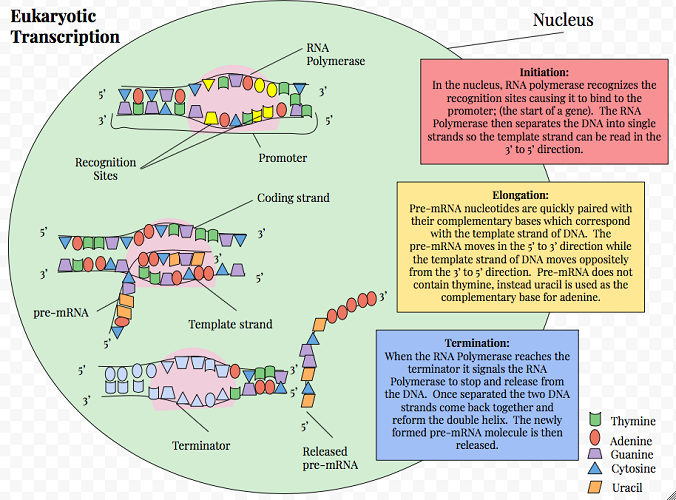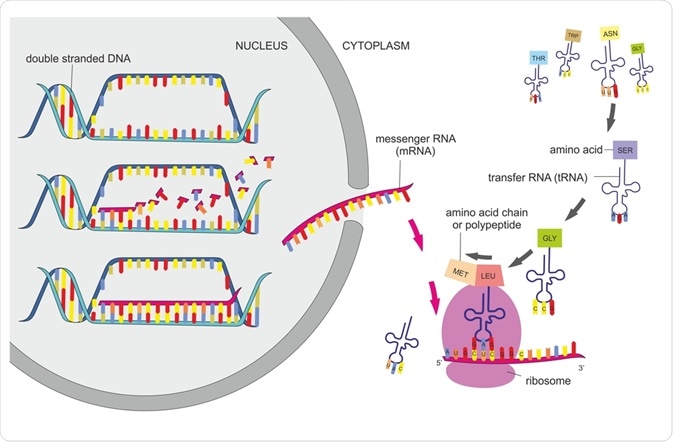Describe the Two Step Process of Protein Synthesis
Initiation elongation and termination. This initial protein synthesis step is known as transcription.
The summary of the various steps in the mechanism of protein synthesis is shown in Fig.

. Protein synthesis is the process in which cells make proteins. Proteins are crucial biomolecules involved in various cellular functioning. The process of protein.
Proteins are functional biological units composed of folded biochemical chains that are involved in almost. This control is possible through the transcription of mRNA. These proteins are produced by the process of transcription and translation.
Initiation Elongation and Termination. Protein synthesis steps are twofold. Later these mRNA templates are used to translate them into amino acids.
This process of protein synthesis occurs in two stages - transcription and translation. Transcription produces an exact copy of a section of DNA. Steps in Protein Synthesis.
Protein synthesis comprises two major parts transcription and translation. This is a two-step process. Transcription is first in the nucleus during which it opens up the gene to serve as a template for building single stranded mRNA then synthesizes mRNA using DNA of a gene as a template then must peel away from the DNA template leave the nucleus.
During translation the mRNA works with a ribosome and tRNA to synthesize proteins. The procedure of synthesizing mRNA templates from DNA molecules is called transcription. Transcription which occurs in the cytoplasm involves amino acid polymerization forming polypeptides based on the instructions.
The ribosome latches onto the end of an mRNA molecule and moves along it capturing loaded tRNA molecules and joining together their amino acids to form a new protein chain. Explain how DNA through the process of protein synthesis is responsible for the ultimate expression of the characteristics in the organism. DNA controls the synthesis of proteins having amino acids in a specific sequence.
1B Describe the steps of protein synthesis Protein synthesis takes place in two major steps. Transcription - It is the process in which mRNA is formed from one of the strands of DNA called the templateantisensenon-coding strand. The process of protein synthesis on 70S ribosomes is described in detail below.
In the second step the amino acid from the aminoacyl-AMP molecule is transferred to a specific tRNA molecule and the. Learn vocabulary terms and more with flashcards games and other study tools. This whole complex of processes is carried out by the ribosome formed of two main chains of RNA called ribosomal RNA rRNA and more than 50 different proteins.
During transcription the information from DNA is encoded into mRNA. Transcription is the transfer of genetic instructions in DNA to mRNA in the nucleus. It occurs in two stages.
During translation the mRNA works with a ribosome and tRNA to synthesize proteins. Protein synthesis is the process in which cells make proteins. The protein synthesis occurs in two steps namely transcription and translation.
The first step consists of the activation of aminoacids. An amino acid molecule reacts with an ATP adenosine. It occurs in two stages.
At some other prior time the various other types of RNA have been synthesized using the appropriate DNA. The process involves ribonucleic acid RNA deoxyribonucleic acid DNA and a set of enzymes. RNAs serve as intermediate molecules between DNA and protein.
Transcription is the transfer of genetic instructions in DNA to mRNA in the nucleus. First deoxyribonucleic acid DNA is transcribed to ribonucleic acid RNA with the enzyme RNA polymerase. Second the RNA is then translated into a protein molecule by ribosomes in the cell.
Start studying 2 Steps of Protein Synthesis. The mechanism of protein synthesis has been studied thoroughly in Ecoli. All proteins are synthesized according to instructions contained in the DNA nucleotide sequence which is unique to every individual Protein synthesis is a two step process that consists of transcription and translation.
Transcription takes place in the nucleus. The protein synthesis occurs in two steps namely transcription and translation. The steps of protein synthesis the process by which genetic information is converted into proteins are transcription translation and in some cases posttranslational modification and protein folding.
Describe how interference in protein synthesis can result in disruption of cellular and bodily processes. Transcription is the creation of mRNA messenger RNA from the DNA. Step 1 Transcription.
One strand of DNA molecule functions as a template for the formation of mRNA. Translation is next in the cytoplasm where a ribosome attaches to the mRNA then the first amino acid is carried into position then. Protein synthesis involve two major steps - Transcription and Translation.
Ribosomes serve as a site for protein synthesis. During transcription the information from DNA is encoded into mRNA. Describe the steps in the process of protein synthesis.
The first step is called transcription and takes place in the nucleus eukaryotes. There are three steps to translation. It includes three steps.
Individual cells construct proteins. Initiation elongation and termination. Genetic code is specific for particular amino acids.
Cells express their genes by converting the genetic message into protein. Firstly the code for a protein a chain of amino acids in a specific order must be copied from the genetic information contained within a cells DNA. The process of protein synthesis occurs in two major steps driven by enzymes inside a cell.
The first step is transcription in which the sequence of one gene is replicated in an RNA molecule. Cell uses the genes to synthesize proteins. It includes three steps.
The ribosome will form around the mRNA strand when a tRNA transfer RNA attaches to a codon called the start codon the most common start codon is AUG. STEP 1The first step in protein synthesis is the transcription of mRNA from a DNA gene in the nucleus. All types of ribonucleic acids namely messenger ribonucleic acid mRNA ribosomal ribonucleic acid rRNA and transfer ribonucleic acid tRNA are required for protein synthesis.

Protein Synthesis Ck 12 Foundation

Comments
Post a Comment